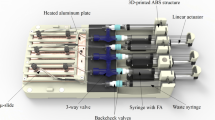Abstract
In the body, connective tissues have a major function in sustaining mechanical stresses. On the other hand, mechanical forces are important factors for connective tissue homeostasis. Connective tissues dynamically interact with mechanical and gravitational stimuli, changing their mechanical properties through the continuous modification of their composition, and thus improving their function. In connective tissues, mechanical forces are major regulators of extracellular matrix turnover, strongly affecting the production of extracellular matrix proteins. On the contrary, unloading conditions, such as bed rest or space flight, have a negative effect on these tissues, with loss of mass and impairment of mechanical properties. Here we describe the effect of photomechanical stress, supplied by a pulsed Nd:YAG laser, on extracellular matrix production by fibroblasts and chondrocytes, and compare it with the effect produced by hypergravity conditions. Cell morphology and structure, extracellular matrix production, cell adhesion, cell energy metabolism have been studied in treated human fibroblasts and chondrocytes by using immunocytochemistry, fluorescence and autofluorescence microscopy. The results show that photomechanical stress induce cytoskeleton remodelling, redistribution of membrane integrins, increase in production of ECM molecules, changes in cell energy metabolism. The effects are similar to those observed in the same cells exposed to cyclic hypergravitational stress (10×g).
Similar content being viewed by others
References
Bloomfield, S.A.: Changes in musculoskeletal structure and function with prolonged bed rest. Med. Sci. Sports. Exerc. 29, 197 (1997), (meglio sostituirla)
Carmeliet, G., Vico, L., Bouillon, R.: Space flight: a challenge for normal bone homeostasis. Crit. Rev. Eukaryot. Gene. Expr. 11, 131 (2001)
Chiquet, M., Sarasa-Renedo, A., Huber, F., Flück, M.: How do fibroblast translate mechanical signals into changes in extracellular matrix production? Matrix Biology 22, 73 (2003)
Croute, F., Gaubin, Y., Pianezzi, B., Soleilhavoup, J.P.: Effects of hypergravity on the cell shape and on the organization of cytoskeleton and extracelluar matrix molecules of in vitro human dermal fibroblasts. Microgravity Sci. Technol. 8, 118 (1995)
Giddings, V.L., Beaupré, G.S., Whalen, R.T., Carter, D.R.: Calcaneal loading during walking and running. Med. Sci. Sports Exerc. 32, 627 (2000)
Johnson, R.B.: The bearable lightness of being: bones, muscles and spaceflight. Anat. Rec. 253, 24 (1998), (meglio sostituirla)
Kajer, M.: Role of extracellular matix in adaptation of tendon and skeletal muscle to mechanical loading. Physiol. Rev. 84, 649 (2004)
Lammi, M.J.: Current perspectives on cartilage and chondrocyte mechanobiology. Biorheology. 41, 593 (2004)
Monici, M.: Cell and tissues autofluorescence. Research and diagnostic applications. biotechnol (invited review). Annu. Rev. 11, 227 (2005)
Monici, M., Marziliano, N., Basile, V., Pezzatini, S., Romano, G., Conti, A., Morbidelli, L.: Hypergravity affects morphology and function in microvascular endothelial cells. Microgravity Sci. Technol. 18, 234 (2006)
Sarasa-Renedo, A., Chiquet, M.: Mechanical signals reglating extracellular matrix gene expression in fibroblasts. Scand, J. Med. Sci. Sports. 15, 223 (2005)
Schneckenburger, H., König, K.: Fluorescence decay kinetics and imaging of NAD(P)H and flavins as metabolic indicators. Opt. Eng. 31, 1447 (1992)
Szafranski, J.D., Grodzinsky, A.J., Burger, E., Gaschen, V., Hung, H.H., Hunziker, E.B.: Chondrocyte mechanotransduction: effects of compression on deformation of intracellular organelles and relevance to cellular biosynthesis. Osteoarthr. Cartil. 12, 937 (2004)
Takahashi, I., Nuckolls, G.H., Takahashi, K., Tanaka, O., Semba, I., Dashner, R., Shum, L., Slavkin, H.C.: Compressive force promotes Sox9, type II collagen and aggrecan and inhibits IL-1beta expression resulting in chondrogenesis in mouse embryonic limb bud mesenchymal cells. J. Cell. Sci. 111, 2067 (1998)
Uva, B.M., Masini, M.A., Sturla, M., Prato, P., Passalacqua, M., Giuliani, M., Tagliaferro, G., Strollo, F.: Clinorotation-induced weightlessness influences the cytoskeleton of glial cells in culture. Brain Res. 934, 132 (2002)
Author information
Authors and Affiliations
Corresponding author
Rights and permissions
About this article
Cite this article
Basile, V., Romano, G., Fusi, F. et al. Comparison Between the Effects of Hypergravity and Photomechanical Stress on Cells Producing ECM. Microgravity Sci. Technol 21, 151–157 (2009). https://doi.org/10.1007/s12217-008-9068-6
Received:
Revised:
Accepted:
Published:
Issue Date:
DOI: https://doi.org/10.1007/s12217-008-9068-6




